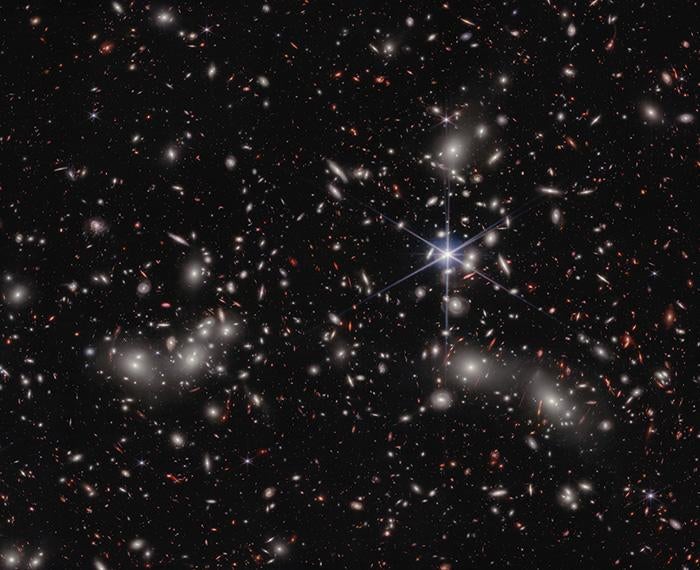
Subscribe to Pittwire Today
Get the most interesting and important stories from the University of Pittsburgh.See the new Webb telescope image that left a Pitt astronomer ‘starstruck’

When it launched in 2021, NASA’s James Webb Space Telescope promised new views on the universe as striking as those of the Hubble. Now it’s delivering, as astronomers today unveiled a new image from the telescope that reveals never-before-seen details around a group of merging galaxies known as Pandora’s Cluster.
“When the images of Pandora’s Cluster first came in from Webb, we were honestly a little starstruck,” said Rachel Bezanson, associate professor in Pitt’s Kenneth P. Dietrich School of Arts and Sciences. “There was so much detail in the foreground cluster and so many distant lensed galaxies, I found myself getting lost in the image. Webb exceeded our expectations.”
Bezanson is one of two leaders of the UNCOVER program that produced the image, a long-exposure shot of three clusters of massive galaxies coming together to form a megacluster. The combined mass of these clusters acts as a lens, boosting researchers’ ability to see the details of galaxies that are much more distant — and from a period when the universe was much younger.
Only Pandora’s central core had previously been studied in detail by NASA’s Hubble Space Telescope. To create the new panorama, researchers stitched four Webb images together, displaying roughly 50,000 sources of near-infrared light. Closely examine the areas around nearer, brighter galaxies on this zoomable version of the image, and you’ll see those distant galaxies as reddish distorted streaks.
“Pandora’s Cluster, as imaged by Webb, shows us a stronger, wider, deeper, better lens than we have ever seen before,” said astronomer Ivo Labbe of the Swinburne University of Technology in Melbourne, Australia, a co-leader of the project along with Bezanson. “My first reaction to the image was that it was so beautiful, it looked like a galaxy formation simulation. We had to remind ourselves that this was real data and we are working in a new era of astronomy now.”
[Read about other ways Pitt astronomers are using Webb to see new views of the universe.]
The UNCOVER team spent a total of 30 hours of time with the telescope to capture the cluster using the Webb’s infrared capabilities and publicly released their data. Next, researchers will select galaxies for follow-up observation to determine their distance and composition, providing new insights into the early era of how galaxies formed and evolved. The UNCOVER team expects to make these observations later this year.
“The ancient myth of Pandora is about human curiosity and discoveries that delineate the past from the future, which I think is a fitting connection to the new realms of the universe Webb is opening up,” said Bezanson.
— Patrick Monahan, adapted from materials from the Space Telescope Science Institute. Photo credit: NASA, ESA, CSA, Ivo Labbe and Rachel Bezanson. Image processing: Alyssa Pagan.

